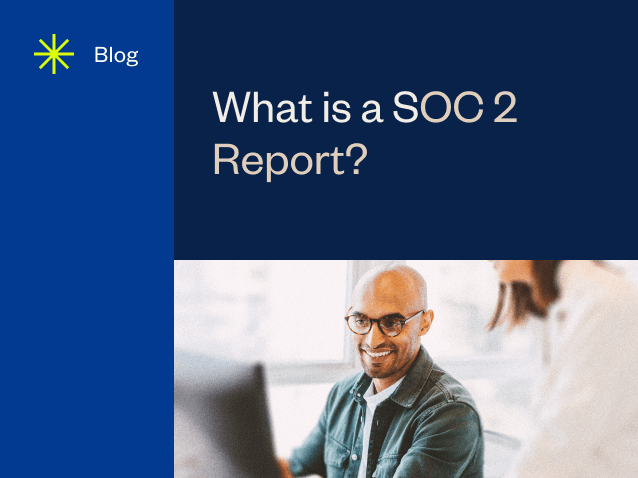A Guide to SOC 2 Reporting: What Is a SOC 2 Report?

If your organization handles customer data or stores sensitive information, you’ve likely heard of a SOC 2 report. These reports are a critical component in evaluating the security of an organization’s sensitive information. A SOC 2 report can provide assurance to customers, clients, and partners that organizations are taking the appropriate measures to protect their data.
As a result, SOC 2 has become increasingly important for companies seeking to maintain trust and credibility in the marketplace. In this article, we’ll provide an overview of SOC 2 reporting by covering its key aspects, including real-world examples and document templates to help further illustrate these concepts.
What is a SOC 2 report?
At its core, a SOC report (System and Organization Controls report) is a comprehensive attestation report conducted by third-party auditors that assesses an organization’s internal controls related to design and operational effectiveness. There are two main types of SOC reports: SOC 1 and SOC 2. While both serve essential functions in evaluating organizational controls, they differ significantly in scope and purpose.
A SOC 1 report specifically focuses on an organization’s internal controls that could impact a user entity’s financial reporting (ICFR), whereas a SOC 2 report addresses an organization’s information systems security, availability, processing integrity, confidentiality, and privacy controls. Both SOC 1 and SOC 2 reports can assess the design and operational effectiveness of controls over a defined period.
A SOC 2 report includes sections addressing:
- Control Environment
- Communication and Information
- Risk Assessment Policies
- Monitoring and Control Activities
- Logical and Physical Access Controls
- System Operations
- Change Management
- Risk Mitigation
Within the SOC 2 framework are two distinct subtypes – Type 1 and Type 2. A Type 1 report describes an organization’s control design at a specific point in time, whereas a Type 2 report evaluates the operating effectiveness of those controls over a designated review period.
Because SOC 2 audit reports are essential for organizations that want to demonstrate their commitment to security best practices, it is critical for businesses to understand specific sections within a report. For instance, within a typical SOC 2 Type 2 report are sections covering:
- The organization’s description of their system’s environment
- The Third Party Assessment Organization (3PAO)’s testing procedures and results
- Any identified exceptions in the organization’s controls design or effectiveness
- Management’s assertion of the fairness of description of the system and environment
Each section of the SOC 2 report plays a vital role in providing a comprehensive understanding of an organization’s compliance with established criteria.
Understanding the importance of SOC 2 reporting
As businesses face increasing scrutiny over their data-handling practices, it is also crucial to be well-versed in the reporting frameworks that govern these evaluations. The SOC 2 framework, for example, includes the Trust Services Criteria established by the American Institute of Certified Public Accountants (AICPA). This framework provides a rigorous set of guidelines that auditors follow when assessing an organization’s controls and processes.
Carrying out a SOC 2 audit can be a complex process involving several steps like scoping the engagement, selecting appropriate trust services criteria (TSC), engaging qualified independent auditors, gathering documentation of controls in place as well as testing control effectiveness over time.
The benefits of SOC 2 reporting templates
Given the complexities involved in protecting sensitive data from unauthorized access or disclosure, many organizations seek out resourceful tools such as downloadable examples (e.g., a SOC 2 report example PDF) or templates (e.g., a SOC 2 reporting template).
A SOC 2 reporting template typically includes detailed instructions to organize relevant information and guidance on creating a clear, concise report that effectively conveys an organization’s control environment to external auditors.
With so much at stake concerning sensitive data protection, organizations cannot afford to maintain an ineffective control environment if they wish to achieve regulatory compliance. As such, organizations should look to SOC 2 reporting templates for assistance in preparing for these critical evaluations.
Prioritizing SOC 2 to help your business
Ultimately, organizations that prioritize robust controls and comprehensive assessments like SOC 2 reports are better positioned to protect their sensitive data and maintain their sterling reputations in an increasingly scrutinized business environment.
SOC 2 reports play critical roles in:
- Evaluating an organization’s internal controls related to control design and operating effectiveness
- Showcasing their commitment to safeguarding client data
- Maintaining robust security controls that help prevent unauthorized access or misuse
- Establishing credibility within competitive markets
Businesses looking for assistance during the SOC 2 reporting process can lean on helpful tools such as SOC 2 report examples and templates. Utilizing these resources can ensure your organization is prepared for the audit process.
Because earning a SOC 2 report is such a crucial component to show commitment to cybersecurity compliance, it is important to work with an experienced audit firm to receive a high-quality report.
Ready to start your SOC 2 journey? A-LIGN is ready to assist with any of your SOC 2 compliance, cybersecurity, and privacy needs. Contact us today.
